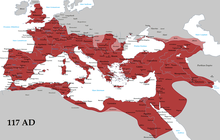Vulgar Latin
| Vulgar Latin | |
|---|---|
| sermo vulgaris | |
| Native to | Roman Republic, Roman Empire |
| Era | Antiquity; developed into Romance languages 6th to 9th centuries |
|
Indo-European
|
|
| (unwritten) | |
| Language codes | |
| ISO 639-3 | – |
|
Linguist list
|
lat-vul |
| Glottolog | None |

The Roman Empire in 117 AD
|
|
Vulgar Latin or Sermo Vulgaris ("common speech") is a generic term for the nonstandard (as opposed to classical) sociolects of Latin from which the Romance languages developed. Works written in Latin during classical times used Classical Latin rather than Vulgar Latin, with very few exceptions (most notably sections of Gaius Petronius' Satyricon). Because of its nonstandard nature, Vulgar Latin had no official orthography. Vulgar Latin is sometimes also called colloquial Latin, or Common Romance (particularly in the late stage). In Renaissance Latin, Vulgar Latin was called vulgare Latinum or Latinum vulgare.
The term "common speech" (sermo vulgaris), which later became "Vulgar Latin", was used by inhabitants of the Roman Empire. Subsequently it became a technical term from Latin and Romance-language philology referring to the unwritten varieties of a Latinised language spoken mainly by Italo-Celtic populations governed by the Roman Republic and the Roman Empire. Traces of their language appear in some inscriptions, such as graffiti or advertisements. The educated population mainly responsible for Classical Latin might also have spoken Vulgar Latin in certain contexts depending on their socioeconomic background. The term was first used improperly in that sense by the pioneers of Romance-language philology: François Juste Marie Raynouard (1761–1836) and Friedrich Christian Diez (1794–1876).
In the course of his studies on the lyrics of songs written by the troubadours of Provence, which had already been studied by Dante Alighieri and published in De vulgari eloquentia, Raynouard noticed that the Romance languages derived in part from lexical, morphological, and syntactic features that were Latin, but were not preferred in Classical Latin. He hypothesized an intermediate phase and identified it with the Romana lingua, a term that in countries speaking Romance languages meant "nothing more or less than the vulgar speech as opposed to literary or grammatical Latin."
...
Wikipedia
